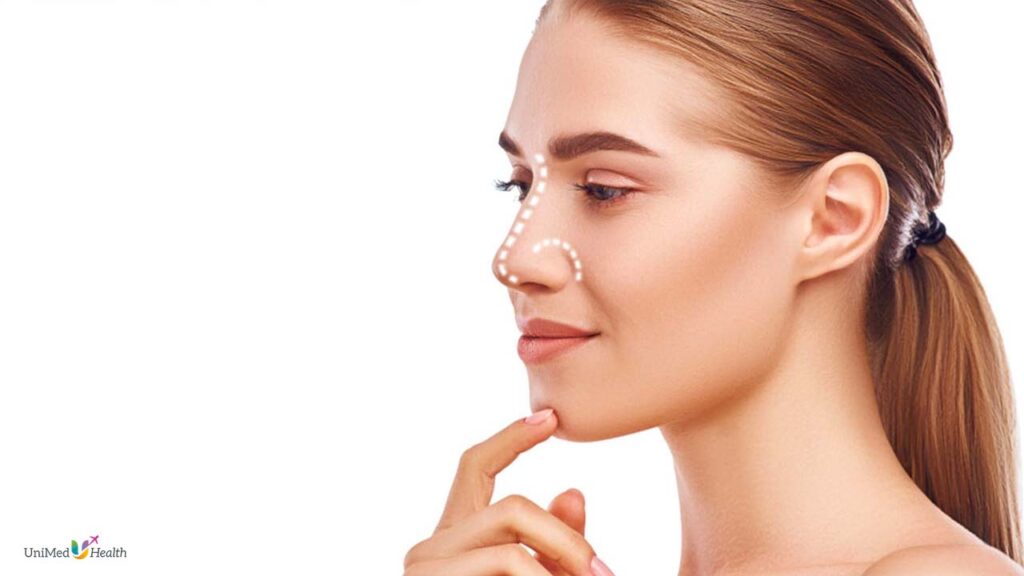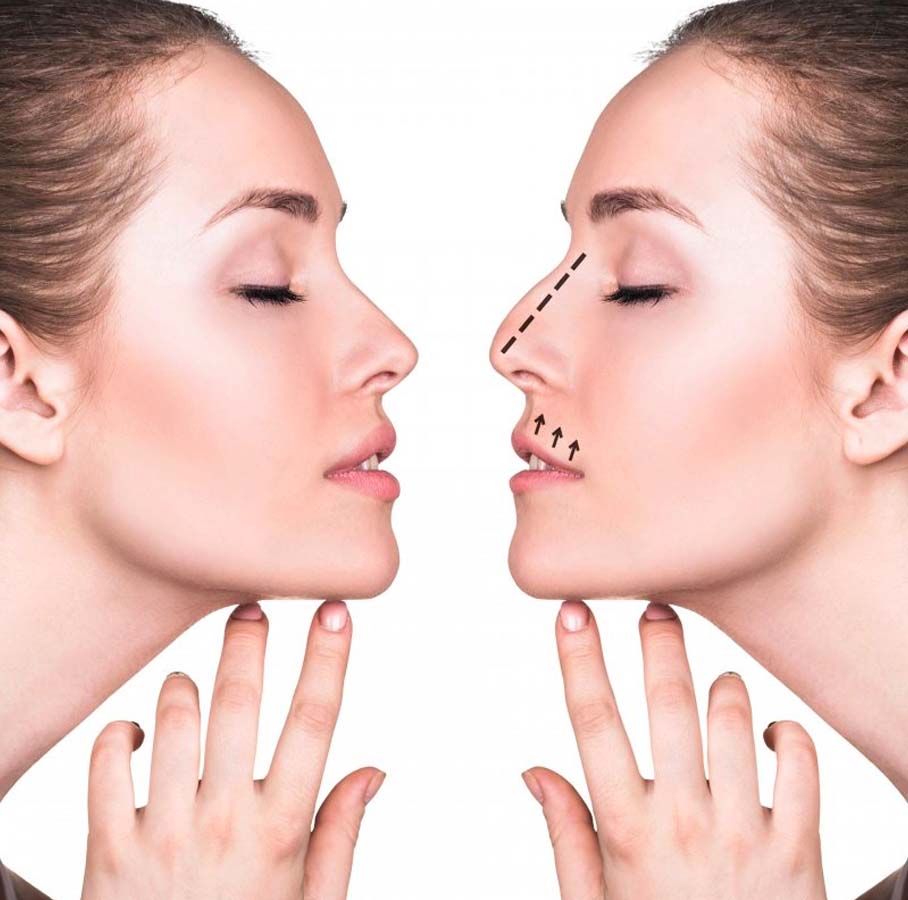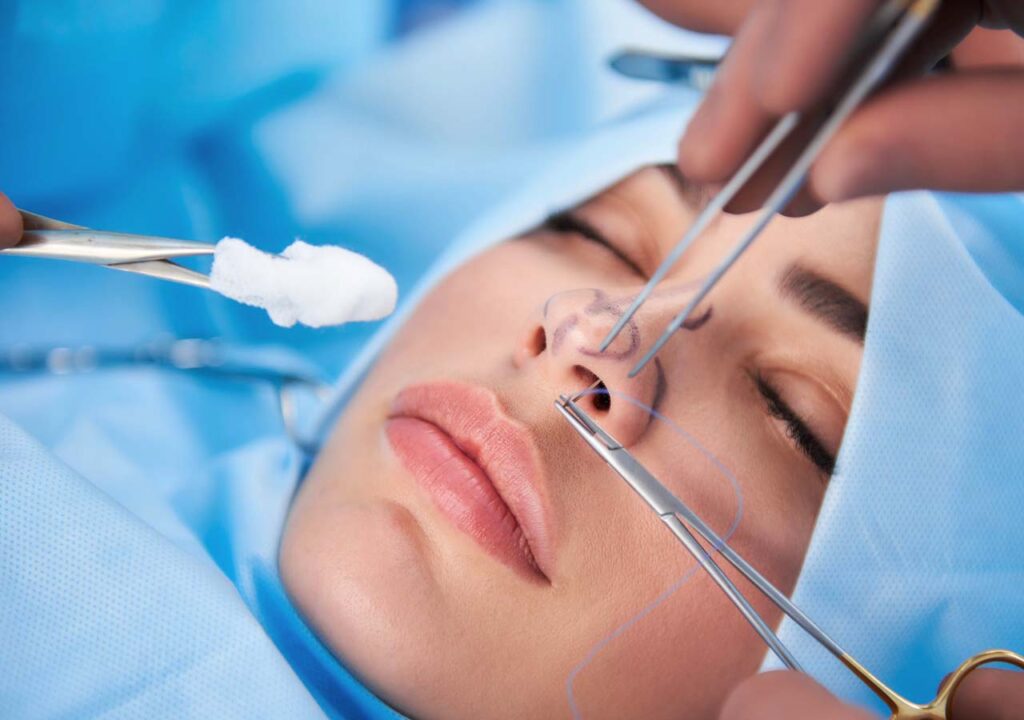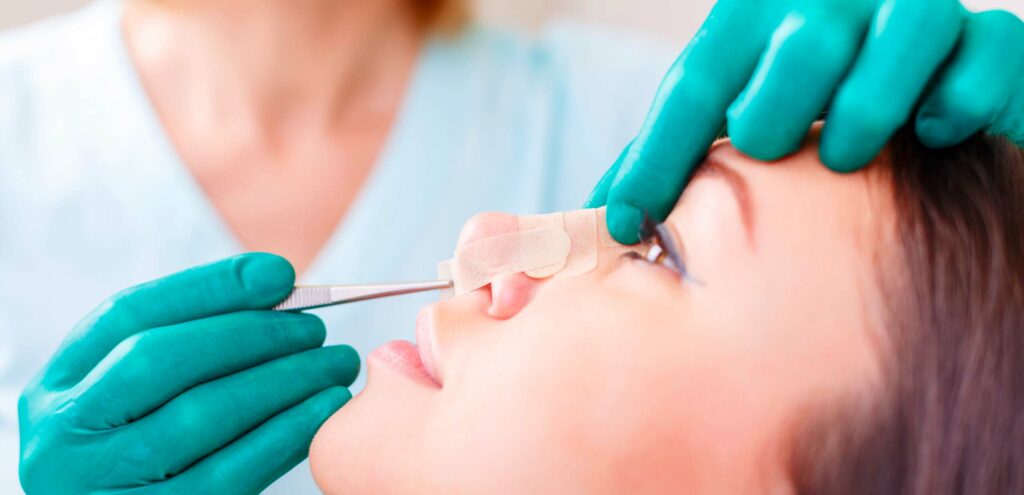RHINOPLASTY
What is rhinoplasty surgery?
Rhinoplasty is a procedure to reshape your nose. The aim of surgery is to relieve the complaints of the patients. In this direction, the nose can be shortened, deformities due to trauma can be eliminated, small noses can be enlarged, and the excess of the belt can be reduced. In short, the aim is to obtain a natural nose that is compatible with the patient’s facial appearance. After the surgery, both the aesthetic concerns of the patients are relieved and a solution is found for their breathing problems.

What can be done with rhinoplasty?

Reduce nose sizes
Increasing the size of the nose: Augmentation rhinoplasty is an aesthetic attempt to increase the projection of the nasal arch in profile view. During augmentation rhinoplasty, surgical silicone implants are used to reshape and enlarge the nose. The selected implant is adjusted specifically for the patient, that is, according to the face shape of the patient. In patients who do not want to use silicone implants, in patients who have had rhinoplasty before, the patient’s cartilage is used to reshape the nose and achieve a more natural appearance. Since the patient will have their own cartilage, there will be an easy union with the nasal tissue. Problems are rarely encountered in this particular subject. This operation technique takes an average of 3 hours and patients are recommended to stay in the hospital for one night after the operation.
To breathe better: Some patients may have breathing problems due to problems in the nasal airways. Generally, your surgeon will try to correct this with procedures such as septoplasty.
Reshaping the tip of the nose, changing the width of the nostrils and angle between the nose and upper lip, and remodeling the bridge of the nose.
There is actually a limit to how much your nose can change. The surgeon’s goal is to give your nose a natural look. This issue depends on many factors such as the patient’s age, skin, the size of your nose, whether you have had nasal surgery before, or you have any disease that affects wound healing. Therefore, you should have transparent communication with your surgeon about what is possible and what is possible and your expectations before the surgery.
What are the types of rhinoplasty surgery?
Closed Nose Surgery
Closed nose surgery is one of the most preferred surgical techniques today. The problems in the nose are eliminated with small incisions made in both nostrils. In the closed technique, the surgeon’s angle of view is narrow, but it can be seen with intranasal cameras. Its advantage is that the incisions remain inside the nose and have relatively shorter recovery times. Since the working area is limited, it is even more difficult to shape the nasal cartilages. These are processes that require much more experience to get results.
Open Nose Surgery
Open nose surgery is performed by removing the skin with a small incision of about half a cm from the lower end of the nose and revealing the bone and cartilage skeleton completely. is performed by removing the skin with a small incision of about half a cm from the lower end of the nose and revealing the bone and cartilage skeleton completely. Due to the nature of the surgery, swelling and edema in the nose take longer to pass. A small scar remains in the columella area. While it is markedly red during the recovery period in the first months, this scar is invisible in the following (6-12 months) and rarely bothers people.

Tip Plasty (Nose Tip Aesthetics)
Tip Plasty (Nose Tip Aesthetics): Our surgeons evaluate the bone, mucosa, and skin structures of the patients. As a result of this evaluation, if the deformity is only at the tip of the nose and in the cartilages, the procedure to be done is tip plasty. Tip plasty is preferred for people who do not have a problem in the nasal bones and are only bothered by the width and lowness of the nose tip. In tip plasty surgery, the cartilages at the tip of the nose are thinned and reshaped, and the ‘hump’ that causes the protruding image on the nasal dorsum can be filed. Tip plasty aesthetics is a surgical procedure that takes an average of 30 minutes under local anesthesia and sedation, the patients go home on the same day and do not disturb the comfort of the patients.
Who needs rhinoplasty?
- In individuals older than 18 years of age, when facial muscles and bones have completed their development (according to some guidelines, it can be done after 16 years for girls and 17 years for boys).
- If you are uncomfortable with the current nose shape or size and have aesthetic concerns about it
- Presence of an injury, damage, or deformity due to previous trauma
- In patients who have difficulty breathing and snoring loudly due to the nasal structure
- Absence of a health condition that would prevent surgery
- The patient who has realistic goals about aesthetic results, feels mentally and emotionally ready for surgery, and can clearly explain his expectations to his doctor.
Why should you have a rhinoplasty?
- After rhinoplasty, patients become more self-confident as their aesthetic concerns are resolved. They become more sociable and active in their social environment.
- Breathing difficulties were eliminated.
- Their sleep quality has improved, they no longer have problems such as snoring, and they start the day more energetically.
- Studies have shown that the frequency of upper respiratory tract infections has decreased in patients.
What to do in the preoperative process?
- Stay as healthy as possible; you need a good diet and exercise program for that.
- If you smoke, quit as soon as you can before surgery. It will accelerate wound healing and reduce the risk of complications.
- It is recommended that you stop using alcohol at least 10 days before the surgery.
- Be sure to tell the doctor before the operation about your medical history, and tell about all the medicines you use.

Overview after surgery
Rhinoplasty surgeries are performed under general anesthesia. It takes an average of 2 hours. You go home the same day or you may need to stay for a day. Antibiotics are given to keep the wound clean after surgery. It is normal for your nose to be tight and sore, you will be given painkillers for this. If your nasal bones are broken during the surgery, you may have bruises around your eyes for 7-10 days. These bruises turn yellow and disappear. Buffer application is not a routine application. In general, a silicone splint is used instead of a residual tampon when necessary to support the cartilage and bone structure that is corrected during surgery. However, tampons are used in patients who underwent septoplasty together with rhinoplasty. It is removed within a week after surgery. Patients may feel pain while removing the used tampon.
Dressings
You may have a dressing in any of your nostrils or a pad under your nose. It can also be a splint to protect your nose. After the splint is removed, you should protect your nose from traumas and impacts as it may affect the results of the surgery
Stitches
According to the technique performed after the surgery, there will be stitches inside and outside your nose. Detailed information about this was given in the open surgery section. The stitches inside your nose will absorb on their own. Stitches outside will be removed in 5-7 days.
Head Position
During the day, the head should be kept as high as possible. Several pillows can be used to provide height while sleeping at night. You should lie on your back for an average of 1 month and also apply cold compression. These recommendations prevent the formation of edema and accelerate the healing process. It is suggested to stay away from actions such as bending, straining, lifting weights, and hot baths, which increase blood flow in your face and thus increase bleeding and edema.
Recovery Process
It is very normal to experience pain and weakness after surgery. Patients’ pain is usually controlled with painkillers. 72 hours after the operation, a significant decrease in your pain occurs. There may be a slight nosebleed in the first 1-2 days. You can wipe it with a clean cloth without damaging your nose, but if the amount of bleeding is high, you should consult your doctor. In the first 1-2 weeks, most of the patients may have bruising and edema. To minimize this, you can read our recommendations above. In general, these symptoms disappear after 2 weeks and the new shape of your nose begins to appear. However, after 6-12 months, your nose will take its full shape. You will get out of bed on the first day after the surgery and you will return to your daily routine within 1-2 weeks on average. The nose should be protected from impacts for 1 month after the operation. During this period, patients should avoid contact sports. Patients are recommended swimming, individual sports, and exercises from the second week.
Glasses Use & Sun Protection
It is possible to wear glasses three months after the operation. There is a consensus that the use of glasses in the early postoperative period will adversely affect the nasal structure. Therefore, the use of lenses is recommended for patients.
It is perfectly safe to go out during the day using high-factor sunscreen after the bruises have disappeared, so a beach holiday can be allowed for 2 weeks after the surgery. It has been reported that the sun’s rays will cause the nasal skin to be red and stained in patients with rhinoplasty.
It may take 6-12 months for the full cosmetic results of rhinoplasty to be understood, so patients should be patient in this process and go through this process by following their doctor’s recommendations.
What is the alternative treatment for the rhinoplasty?
There is no surgical alternative to rhinoplasty. However, non-surgical curvatures due to impact can be corrected, and nasal tip and symmetry can be improved by injecting fillers to certain points in the presence of developing technology without surgery. However, the results of these non-surgical methods are temporary.
After rhinoplasty surgery, you should prefer clothes that are easily tied from the front and back. This is recommended to avoid contact with the surgical site during donning and removal.
